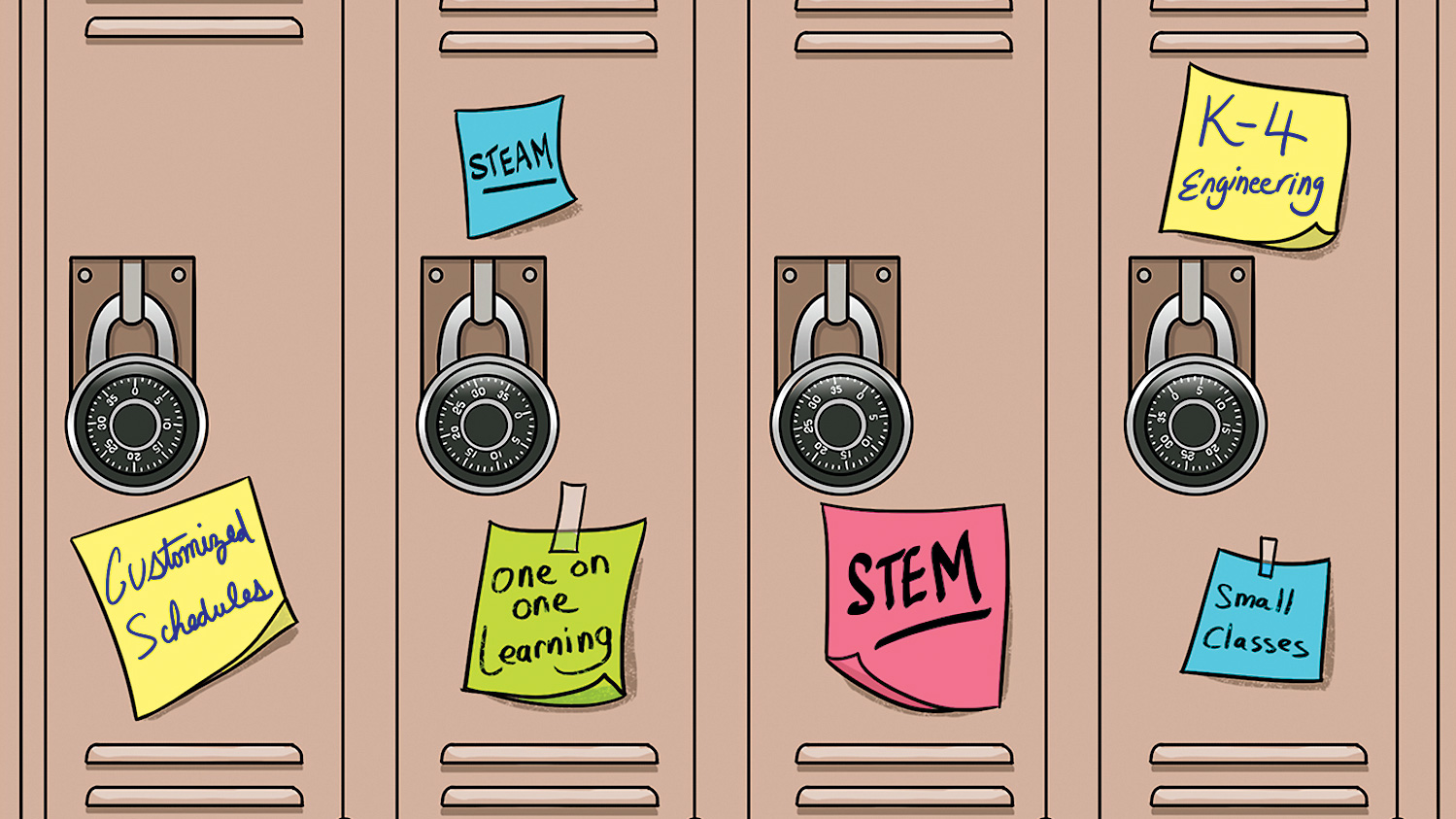Not so long ago, Washington’s private-school landscape was fairly fixed: There were some parochial schools, a couple of military schools, and a handful of titans with well-known reputations—preppy St. Albans, liberal Georgetown Day, sporty Landon. But like so many other stable markets, the private-school universe is being disrupted.
If the people behind one of the region’s newest start-up private schools are to be believed, the future of independent education is unfolding in a mirror-tiled building near the Van Ness–UDC Metro station. Fusion Academy launched its first school year in September, promising a novel form of one-on-one education: total customization of academic schedules, with each student able to select classes starting anytime between 7:30 am and 5:30 pm.
It’s a level of control that more established schools don’t offer—and that fits the bespoke ethos of 21st-century America. Also like that ethos, it isn’t cheap: Fusion’s high-school tuition can run up to $46,200 a year. By comparison, Sidwell Friends charges $39,360, Maret $36,730.
Thus far, Fusion isn’t exactly swiping vast numbers of students from those schools—this fall, it will educate roughly 30 middle- and high-schoolers. But private-school watchers see a lot of room for growth. Martha Ein, a consultant with the Stixrud Group, says the program is an “enticing prospect for families who can afford it,” particularly for students intensely committed to an extracurricular activity (say, a top swimmer), those with special learning needs, or those disenchanted with the traditional classroom setting.
Here’s how Fusion works: A full course load means six classes a semester, from a menu of eclectic options such as Recording Arts. Each subject’s teacher—Fusion’s staff comes from both public- and private-school backgrounds—works one on one with each student. Students interact with one another during “homework” blocks between classes.
That flexibility has other rewards, too, according to Juleanna Glover, whose 16-year-old daughter is enrolled at Fusion after eight years at a DC public school and a Catholic school. “Now she can ride horses like a maniac every day and work at the family farm,” Glover says, “and not have to stay up until 11 doing homework.”
Fusion is one of several new takes on private education that have entered the Washington marketplace in the past year. Slowly but surely, according to nearly a dozen education consultants and administrators interviewed, these new models are reframing the area’s private-school hierarchy, placing a new premium on flexibility, individual attention, and data-driven performance metrics. The standard bearers may soon find themselves playing catch-up.
“We’ve really become spoiled for choice here,” says Leigh Ann Cahill, a director at Independent School Options. “When you have an area this wealthy, it lends itself to getting kids whatever they need, whenever they need it. Tradition is no longer the selling point it once was.”
So echoes Sean Aiken, head of school at Basis Independent McLean. Like Fusion, Basis is open for its first fall semester this year, and it trumpets a rigorous curriculum that aims to prime students for “the global marketplace,” with an engineering course required for kindergarten through fourth grade—an early start for a subject that in most schools is reserved for high-schoolers. Basis boasts a cheaper price than Fusion: High-school tuition for the 2017–18 school year will be $26,900.
“Families in this area are very, very focused on education,” Aiken says. “As an administrator, one of the things I consistently hear is that as much as there’s a storied history of DC schools, there’s not a lot of information to see how they compare”
When contacted about any innovations and features added to St. Albans in the past year, a representative of the private boys’ school in Northwest DC declined comment, saying the school doesn’t participate in articles in which “side-by-side comparisons” could be made.
Some of the would-be disrupters, on the other hand, think that parents in the Amazon era will be leery of institutions that don’t let them compare via data—even institutions as subjective as schools. “Parents are starting to take note of that, too,” Aiken says. “We can’t just silo ourselves off and say, ‘We know we’re good just because.’ Comparative value has now become vital.”
“The way that everyone is thinking about education is changing, because the world is changing,” says Lee Palmer, head of school at Blyth-Templeton Academy on Capitol Hill. “Everyone involved in education right now is reflecting on how to stand out.”
Palmer has been in traditional private-school settings her whole career, most recently as principal at Sidwell Friends. In 2014, she branched out to start her own program. “Sidwell is a wonderful school,” she says, “but I felt like it was time to think about innovative approaches in new settings.”
All these new offerings make the local education landscape more diverse than ever, reflecting not only realities of the marketplace but also the demands from parents.
Thus Blyth-Templeton, an “experiential learning” program in the historic Hill Center at the Old Naval Hospital. Palmer has long been an advocate of small classrooms—Blyth-Templeton averages eight students per class—along with a pace that allows for deeper immersion. Students take only two classes a term, a schedule that allows for weekly, if not daily, outings within the District, with teachers often using museums as backdrops for lessons. “We don’t even call them field trips,” Palmer says, “because it’s just a normal part of the day.” With tuition just under $15,000, the school boasts one of the most “accessible” private schools in the area.
Palmer says the experiential-learning model gives students an edge in college admissions. “We feel that we’re better prepping kids for college because we offer a collegiate experience,” she says. “All the classes are seminar-based with ultra-individualized attention. The kids are learning to self-advocate and be independent, as opposed to learning a lot of content but then not being able to apply it and solve problems.”
For Palmer, that’s a crucial point. While the new menu of private-school options may offer individualization, when it comes to time-honored college-admission results, traditional private schools have records to boast of. Glover admits that this was a consideration in her decision to move her daughter to Fusion. While traditional private models, in her view, may have offered an imperfect experience, she says “there’s definitely a beaten path” when it comes to elite-college admissions.
Palmer says that perception is becoming outdated: “This is just not the way it works anymore—if you go to X prep school, you’ll go to Y college. The future is different from what it was 20 years ago. We have students applying to Ivies, taking gap years, and everything in between. So just like Sidwell and National Cathedral School and any other, they’ll go where’s right for them.” Students at Blyth-Templeton’s original iteration in Canada, Blyth Academy, have been accepted to Harvard, Dartmouth, Cornell, Cambridge, and Oxford.
It may be coincidence, but the past three years have witnessed an arms race of sorts among private schools for state-of-the-art facilities—an area in which newer programs, lacking well-oiled fundraising operations, simply can’t compete.
In September, NCS will complete a new two-story library with a space dedicated to “multimedia instruction,” capping a year of developments that also included an “engineering garage.” Holton-Arms in Bethesda launched its own Center for the Advancement of STEM (science, technology, engineering, and math), ushering in its third class of “STEM Scholars” this year.
In the past two years, Washington International School has implemented a “one-to-one” program, in which each student, beginning in sixth grade, is expected to bring an iPad to school. The school has also begun drawing up plans for a new STEAM (science, technology, engineering, arts, and math) building on campus. “I can’t say that what happens in the marketplace doesn’t have some influence on that,” says director of communications and marketing Kimberly Bennett. “If you want to keep up an offer of superlative education to your student, you have to keep looking around.”
But she also notes how, in the effort to remain cutting-edge, features that were once selling points for traditional private schools could now be drawbacks. Washington International School’s Cleveland Park campus is a registered historic site, a status that has presented an obstacle for moving ahead with construction of the STEAM building. Says Bennett: “Our community is really excited, but we’re still looking to get approval from the Historic Preservation Review Board.”
All these new offerings make the local education landscape more diverse than ever, reflecting not only realities of the marketplace but also the demands from parents. That Washington has responded so quickly to those demands is encouraging, says Cahill, the Independent School Options director. But as so-called customizable education becomes more popular, she worries it could become a crutch for students.
“It’s an interesting discussion to have,” Cahill says, “because although we want kids to learn to their strengths, it’s also important that they don’t become isolated and at times are forced to say to themselves, ‘Well, I don’t want to do it this way or work with these other students, but I have to deal with it.’ ”
She pauses. “So for those in the education sphere, we’re sitting here noting: Yes, this is becoming a huge trend. But do we really want it to be?”



















